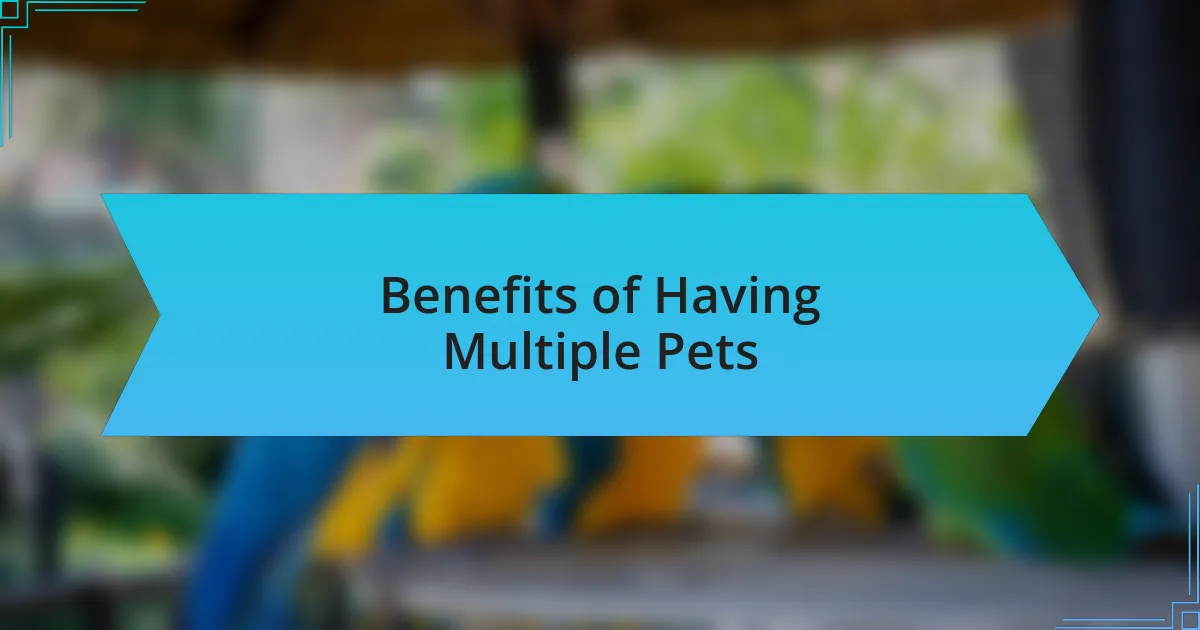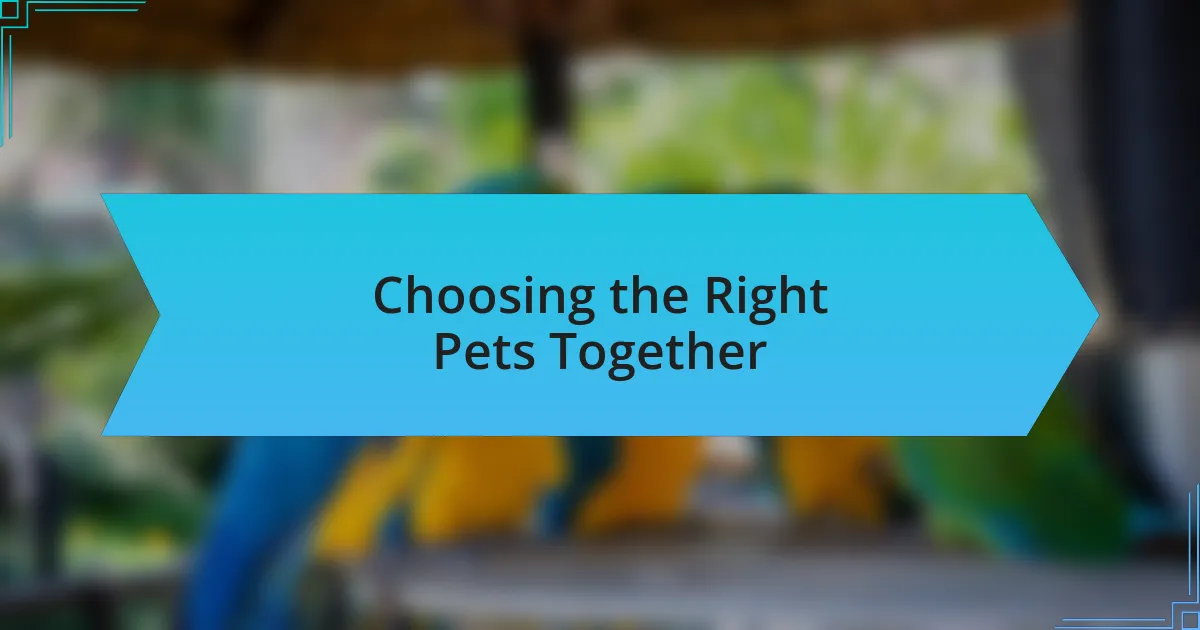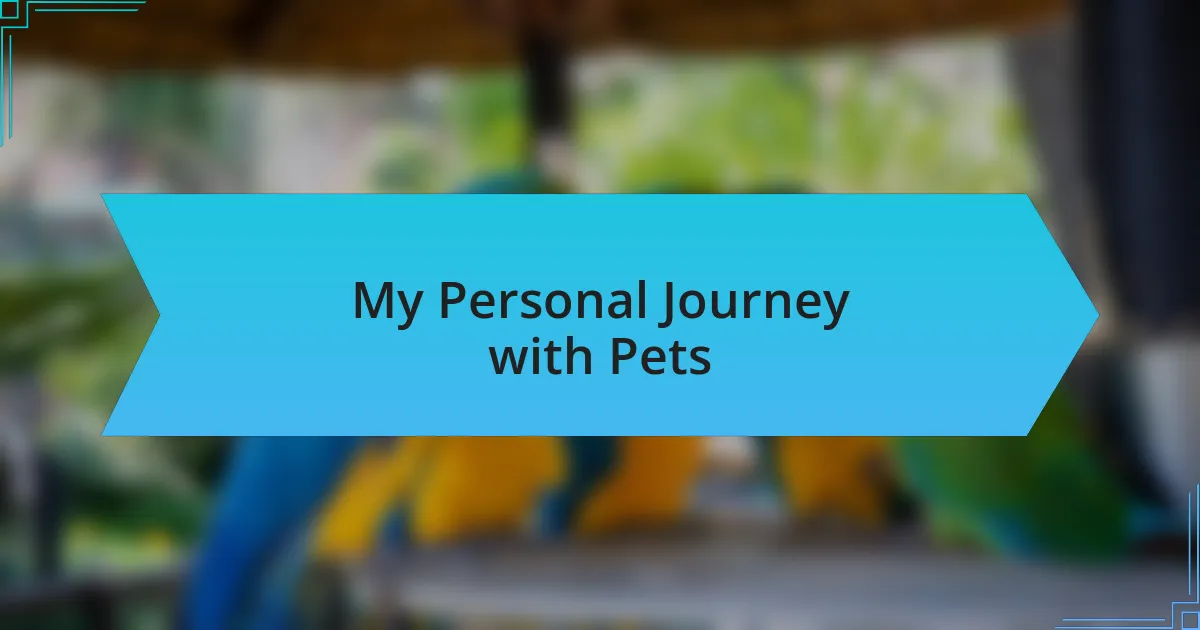Key takeaways:
- Understanding the dynamics of pets’ personalities and communication is essential for creating a harmonious multi-pet household.
- Establishing routines and structured environments helps reduce competition and stress among pets.
- Careful consideration of pet selection based on size, temperament, and energy levels can foster better compatibility.
- Successful introductions between pets involve gradual exposure and monitoring, ensuring positive experiences together.

Understanding Multi-Pet Households
In a multi-pet household, every animal has its unique personality, creating a lively and dynamic environment. I remember when I first adopted my second dog; his playful energy brought out a whole new side of my older pet. How can we harness that energy to create a harmonious home?
Understanding the social dynamics among different pets is crucial. I’ve witnessed my cat’s initial jealousy turn into a protective bond with my new puppy. Have you ever observed how pets communicate through body language? It’s fascinating to see these interactions unfold, and you quickly learn to read their signals.
Conflict and competition can arise in multi-pet setups, especially during feeding times or when toys are involved. I once experienced a minor scuffle between my pets, which reminded me that establishing boundaries is essential. Why is it important to create a structured environment for your pets? A little preparation goes a long way in ensuring everyone feels secure and loved.

Benefits of Having Multiple Pets
Having multiple pets can significantly reduce loneliness for both the animals and their owners. I remember arriving home after a long day, only to be greeted by a symphony of happy barks and purrs. It’s incredible how the simple presence of my pets lightens my spirits and makes my home feel alive.
Another benefit I’ve noticed is the opportunity for pets to socialize and bond with each other. When I brought in my second cat, I was surprised to see how quickly my first cat adapted. They began playing together, grooming each other, and even napping side by side. Isn’t it heartwarming to witness such genuine companionship develop right before your eyes?
Of course, having multiple pets can also impart valuable lessons in responsibility and empathy, both for owners and children. When my niece visits, she learns to care for each pet, from feeding to playing, which I’ve seen deepen her understanding of kindness. How often do we get to teach younger generations about the importance of compassion through these furry friends?

Preparing for Multi-Pet Dynamics
Preparing for a multi-pet household can seem overwhelming, but taking a few key steps can make all the difference. I remember when I added my first dog to the mix; I spent hours rearranging furniture and organizing my space to ensure everyone had their own territory. It’s amazing how a few changes in layout can help alleviate potential conflict and ensure that each pet feels secure in their environment.
Communication is crucial too. My previous experiences taught me to observe pets closely and recognize their body language. For instance, I once underestimated a growl during playtime, thinking it was harmless. It turned out to be an important signal. Taking the time to understand each pet’s unique personality can help you anticipate their needs and prevent misunderstandings.
Additionally, creating routines can facilitate smoother dynamics. In my own household, I found that establishing feeding schedules and designated playtimes significantly reduced competition among my pets. Have you tried similar routines? It’s rewarding to see how a structured environment can lead to harmonious interactions, allowing everyone, including me, to relax and find joy in each other’s company.

Choosing the Right Pets Together
Choosing the right pets to share your home can be quite the puzzle. I still remember the day I decided to adopt a second dog after my first, thinking it would be a seamless addition. However, I quickly learned that not every breed interacts the same way; my calm Labrador had a tumultuous adjustment period with the more energetic terrier. Have you ever considered how differing energy levels can affect your pets’ harmony?
It’s also important to think about their size and temperament. When I brought home my cat, I was surprised at how her confident demeanor clashed with my more timid dog. Choosing pets that complement each other can create a much more peaceful environment. I often remind myself that a little research goes a long way—considering factors like age, breed, and personality traits could save you from future conflicts.
Another tip is to think about how pets will fit into your lifestyle. I learned this the hard way when I adopted a second cat. They had different needs for play and socialization that I hadn’t anticipated, and suddenly I was juggling schedules. How do your current commitments align with what your potential pets might require? Understanding this balance can really enhance your multi-pet experience and foster a stronger bond among them.

Tips for Smooth Introductions
When introducing a new pet to your household, setting up a controlled environment is crucial. I vividly recall the first time I let my new kitten explore the house while my older cat watched from afar. The tension in the room was palpable! To ease the process, I kept them separated at first, allowing them to observe each other through a gate. This initial distance helped reduce anxiety, letting both pets adjust at their own pace.
It’s also vital to monitor their interactions closely during their initial meetings. I remember the first proper introduction of my two dogs. I was on edge, watching for any signs of aggression or discomfort, but surprisingly, they cautiously sniffed each other. Gradually, I became more relaxed as they began to engage in playful behaviors. Creating positive experiences, like feeding them treats simultaneously, can go a long way in promoting a peaceful relationship. What small, positive steps can you take to encourage friendship between your pets?
Involving both pets in shared activities can also help solidify their bond. I found that taking walks with both my dogs not only allowed them to experience each other outside the home but also established a sense of teamwork between them. I would often engage them in games that required cooperation, reinforcing the idea that they could have fun together. Have you thought about how much joy shared experiences can bring? Building these positive memories together truly lays a strong foundation for a harmonious multi-pet household.

Managing Pet Interactions Effectively
To effectively manage pet interactions, it’s essential to observe their body language closely. I remember a moment when my dog’s tail began to droop during a meet-and-greet with my new cat. Sensing his discomfort, I swiftly intervened, allowing him to retreat to a safe space. This taught me that recognizing signs of stress can prevent potential conflicts and build trust between my pets.
Creating safe spaces for each pet is another strategy I found invaluable. I set up cozy corners in different rooms where both my dogs and cat could retreat when they needed a break from each other. Establishing these sanctuaries not only helped them cope with the adjustments but also fostered a sense of security. Have you considered how important it is for your pets to have their own safe havens?
Furthermore, maintaining a routine during this transition period greatly contributed to their wellbeing. I made a point to stick to their feeding and play schedules to reduce uncertainty. This consistency helped my shy cat feel more at ease, while my energetic dogs thrived on the predictability. It made me wonder—how can a simple routine bring peace to a multi-pet household? It’s a reminder that structure can alleviate stress for both pets and their humans.

My Personal Journey with Pets
I vividly remember the first time I decided to adopt my second dog. It wasn’t just about adding another furry friend; it was about creating a dynamic that would enhance our family life. I felt a mix of excitement and anxiety, pondering, “Would they bond or compete for my attention?” That day, as I introduced them in my living room, I couldn’t help but hold my breath, hoping for that instant connection.
As I navigated the challenges of blending two distinctive personalities, I learned that patience is truly a virtue. There was a moment when my new dog playfully nipped at my first dog’s ear, and I observed the look of confusion on my original pet’s face. It was then I realized that understanding their individual traits is crucial. How do you balance their needs while fostering camaraderie? I found that engaging in shared activities, like hikes or even simple backyard playtime, gradually built a bond that was heartwarming to witness.
Looking back, I’ve come to appreciate how each pet brings a unique flavor to the household. The subtle quirks of my cat, who loves to perched atop the bookshelf, and the playful antics of my dogs made every day an adventure. It taught me the importance of celebrating these differences, even when it meant managing occasional conflicts. Have you ever noticed how these little moments can teach us about empathy and companionship? For me, embracing the chaotic yet beautiful nature of a multi-pet household has been one of life’s greatest joys.